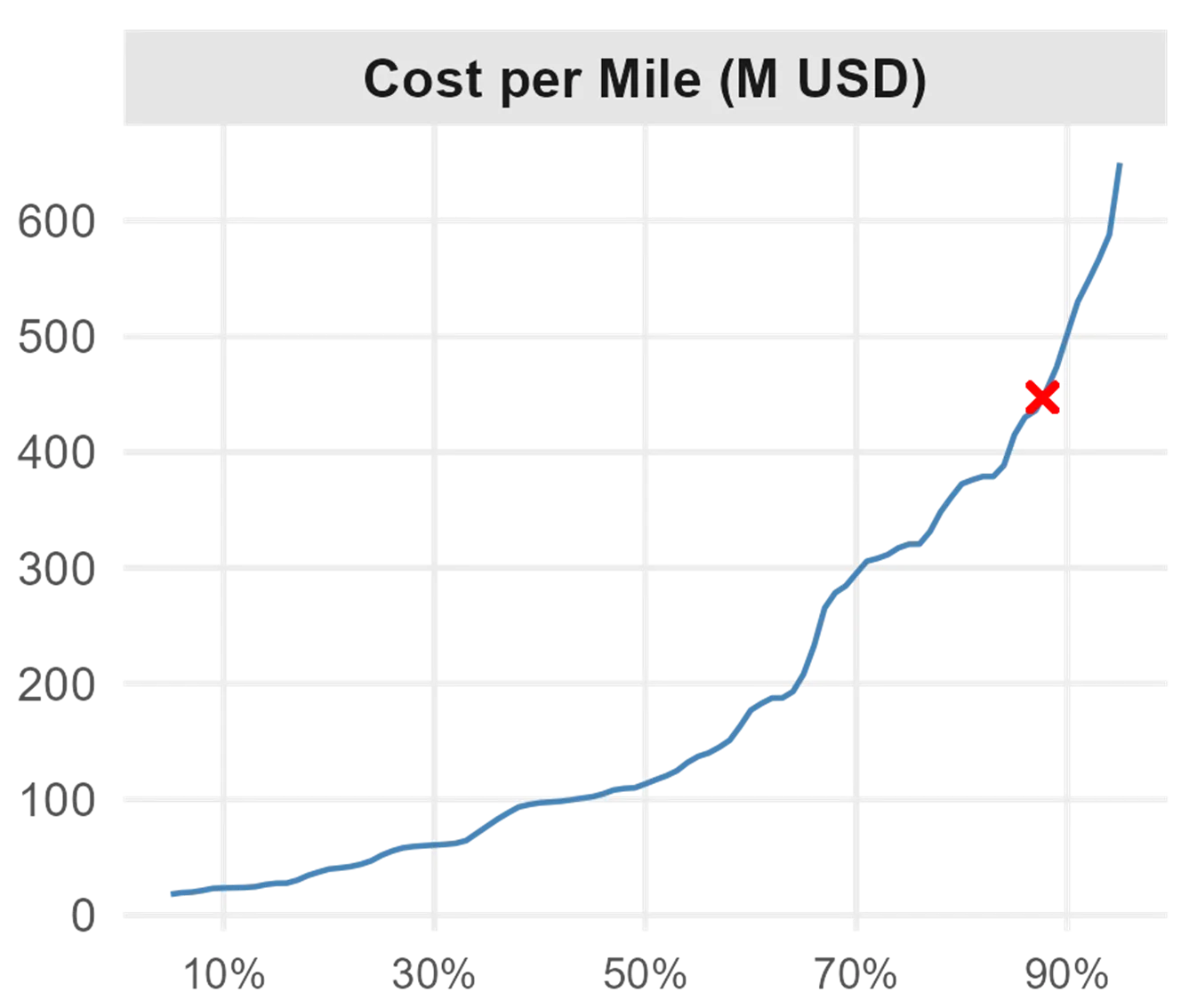California’s $20.1bn (£15.3bn) Delta Conveyance Project (Delta Water Tunnel) will be the largest water infrastructure investment in the state’s history, at a planned length of 72.5km, an 11.9m external diameter and a planned schedule of 14 years of construction. Yet, evidence shows its true cost is likely $27-32bn (£20.5-24.3bn), making it one of the most expensive and extensive bored tunnels ever attempted globally.

Michala Techau is head of resilience and sustainability at Oxford Global Projects
Our benchmarking analysis, based on a reference class of 86 completed tunnel megaprojects, reveals that the Delta Tunnel’s current cost estimates and planned schedule are inconsistent with global evidence.
The Delta Tunnel’s unit costs already place it near the 90th percentile of its global peers before construction begins, sitting on a steep curve where minor disruptions typically translate into massive cost escalation.
Given the Delta Tunnel’s low design maturity (currently estimated at around 5−10%) and the high risk inherent to its extraordinary length and diameter, not to mention the uncertain geotechnical profiling of the delta, our Reference Class Forecasting (RCF) suggests that a conservative contingency requires a cost budget between 75% and 107% above the baseline estimate, pushing the likely final cost toward the $33bn (£25bn) (Figure 1).

Gareth Dooley is senior expert at Oxford Global Projects
Furthermore, it is prudent to consider an even higher contingency, as the projects included in the reference class were at a significantly higher maturity level at the time of final cost estimation compared to the Delta Tunnel.
This project is high-risk and decision-makers must recalibrate cost estimates to reflect the full statistical probability of overrun.
Figure 1:

Figure 1. Delta Tunnel Cost Scenarios and Reference Class Forecast Uplifts. The baseline cost is calculated as $20.1bn minus a 30% contingency, as informed by the Delta Conveyance Design & Construction Authority (DCA), a joint powers authority comprised of public water agencies served by the Department of Water Resource’s State Water Project. The RCF P50 and P80 are provided for water and road tunnels (N = 86). The RCF uplift is added to the baseline cost of $15.5bn USD, i.e., the estimated cost without contingency

Dirk Pöker is senior researcher at Oxford Global Projects
A strategic ‘outside view’ on project risk
Tunnel megaprojects are notoriously challenging. Decades of data confirm Professor Bent Flyvbjerg’s “Iron Law of Megaprojects”: major schemes are consistently “over budget, over time, under benefits – over and over again”. To move beyond optimistic internal projections, a robust method is required.
Reference Class Forecasting (RCF) is a statistical method that takes an “outside view” by using the actual performance of past, similar projects to predict the probability distribution of future outcomes, thereby systematically removing planning bias. The RCF method, pioneered by Professor Daniel Kahneman and further developed by Flyvbjerg, is now the recommended standard for major capital investment in many countries.
Benchmarking the Delta Tunnel’s unit costs
Our analysis compares the 72.5km-long, 11.9m-diameter Delta Tunnel currently being proposed by the California Department of Water Resources against 20 completed water tunnels and 66 road tunnels (completion year range from 1982-2025). To achieve a like-for-like comparison, we normalize the total budget into key unit metrics. As Table 1 shows, the Delta Tunnel is already an outlier in terms of cost per mile.
Table 1: Summary of the Delta Tunnel’s Estimates (DCP) vs. Benchmark Distributions

The high per-mile cost of $447M (£339M per mile or £211.5M per km) places the project near the very edge of historical precedent. This precarious position is best illustrated by the distribution of unit costs, which become acutely sensitive at the upper end (see Figure 2).
Figure 2 illustrates the non-linear relationship between percentile rank and unit cost. The Delta Tunnel sits on the steepest part of the cost distribution curve. This is the zone of “tail risk”, where a move of just a few percentiles (due to unexpected ground conditions or delays) corresponds to a disproportionately massive increase in unit cost. The margin for absorbing shocks is minimal.

Figure 2. Cost metrics for cost per mile, based on pooled data from water and road tunnels.
The magnitude of overrun risk
To quantify the cost and schedule risks, we first examine the historical performance of similar projects. The data in Table 2 confirm that cost overruns are the norm, not the exception.
Table 2: Cost and Schedule Overruns by Tunnel Type

The median water tunnel in our dataset exceeded its initial baseline cost estimate by 34%. However, the crucial metric for strategic planning is the P80 confidence level, which provides an 80% probability of delivering the project on budget or better. Given the Delta Tunnel’s scale, low maturity and complex geology, relying on anything less than P80 is an irresponsible gamble, as warned by the project’s own AACE classification.
The Delta Conveyance Design & Construction Authority (DCA)’s current $20.1bn budget includes a contingency of approximately 30%. Our RCF analysis shows that this 30% contingency translates to an estimated P50 confidence level for the pooled reference class, meaning there is a 50% probability that the project will overrun the current budget (and it translates to a P40 if comparing to water tunnels alone, i.e., a 60% chance of cost overrun).

Overview of the Delta Conveyance project
RCF recommended uplifts: The true cost
To reach a minimum 80% probability of project delivery within budget (P80), the RCF outputs recommend the following uplifts (shown in Figure 1 for pooled tunnel data sample):
- Water tunnels only (P80): A 75% cost uplift is required, equating to a total budget of $27.1bn (£20.6bn).
- Pooled (water and road) tunnels (P80): A 107% cost uplift is required, equating to a total budget of $32.1bn (£24.4bn).
For the schedule, the water tunnel RCF requires a 71% schedule uplift to reach a 90% confidence level. Based on the planned 16-year program, this suggests a more realistic completion timeline of up to 27 years, based on the historical delays of water tunnels, as seen from our reference class of 20 water tunnel projects. We found that, holding all else constant, extending a project’s duration by one year increases the cost per mile of tunnel by 7.5%. In practical terms, longer durations introduce prolonged exposure to inflation, market fluctuations, and unforeseen risks, all of which contribute to higher unit costs.
Key risk drivers and take-home messages
The project’s risk exposure is magnified by four structural drivers confirmed by multivariate regression analysis:
- Exceptional length and diameter: At 72.5km in length and 11.9m in diameter, every additional kilometre and metre is statistically linked to an increase in cost overrun risk. The largest tunnels in the dataset are up to 83km in length and 14.3m in diameter and the data also show that every additional mile (1.6km) of tunnel length is associated with an approximate 1% increase in cost overruns.
- Prolonged project duration: The 16-year schedule significantly raises baseline unit costs due to prolonged exposure to inflation, market fluctuations, and unforeseen events.
- Depth and geotechnical uncertainty: The project’s 47.2m average depth is near the threshold where schedule overruns accelerate sharply (for tunnels at depths of 50-100m, there is an additional 23% risk of cost overrun). Critically, the tunnel crosses soft Delta soils with limited geotechnical profiling. Projects encountering unexpected geology typically experience slower advance rates and significantly higher cost and schedule risks.
- Low maturity: The current cost estimates for the Delta tunnel, as provided by DCA, are based on a design completion of only 5−10% for the main tunnel, classifying them as Class 5 estimates under AACE 17R-97, which carries a potential accuracy range of ±50% to ±100%. Our RCF is based on actual outturn costs divided by estimated costs at the Final Investment Decision point, which is a much higher maturity than 5-10% and hence at a lower risk. The $32.1bn (£24.4bn) is therefore still a very conservative estimate, considering the low maturity of the Delta Tunnel.
The take-home message: The current $20.1bn (£15.3bn) estimate for the Delta Tunnel is not a realistic delivery budget; it is a P40-P50 projection for a project that, due to its low maturity and high complexity, should be planned with a P80 contingency.
Conclusion
According to the State of California and the DCA, the Delta Tunnel project is an important water project, but it is currently framed using estimates that do not account for empirical evidence from global and similar tunnel megaprojects.
The combination of low design maturity (5-10%), limited geotechnical understanding and an extraordinary physical scale exposes the Delta Tunnel to extraordinary risk of being another victim of the “Iron Law” unless planning is fundamentally changed. Treating the $20.1bn figure as a definitive cost masks the considerable uncertainty inherent at this early stage. This is a failure of strategic realism.
For a responsible investment decision, public water agencies considering investing in this megaproject should demand an RCF-derived P80 budget, reflecting the high probability of cost and schedule overruns. A more realistic investment range is likely between $27.1.bn (£20.6bn) and $32.1bn (£24.4bn) and the construction timeline is expected to exceed 25 years. In megaprojects of this magnitude, risk planning is not optional: it is the essence of engineering realism, good governance and public accountability.
- Michala Techau is head of resilience and sustainability at Oxford Global Projects
- Gareth Dooley is senior expert at Oxford Global Projects
- Dirk Pöker is senior researcher at Oxford Global Projects
Read Oxford Global Projects’ Delta Tunnel benchmarking analysis in full here.
Like what you’ve read? To receive New Civil Engineer’s daily and weekly newsletters click here.



